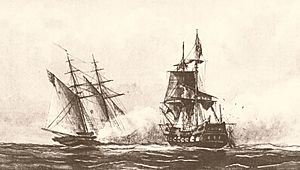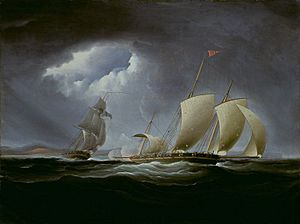Action of 1 August 1801 facts for kids
Quick facts for kids Action of 1 August 1801 |
|||||||
|---|---|---|---|---|---|---|---|
| Part of the First Barbary War | |||||||
 USS Enterprise fighting the Tripolitan polacca Tripoli. William Bainbridge Hoff, 1878 |
|||||||
|
|||||||
| Belligerents | |||||||
| Commanders and leaders | |||||||
| Rais Mahomet Rous | |||||||
| Strength | |||||||
| 1 schooner 90 men |
1 polacca 80 men |
||||||
| Casualties and losses | |||||||
| None | 30 killed 30 wounded 1 polacca disabled |
||||||
The action of 1 August 1801 was a exciting battle between two ships during the First Barbary War. It happened off the coast of what is now Libya. The American ship, a schooner named USS Enterprise, fought against the Tripolitan ship, a polacca named Tripoli.
The Enterprise was part of Commodore Richard Dale's fleet. This fleet was blocking the port of Tripoli. Lieutenant Andrew Sterett commanded the Enterprise. He was sent to get supplies in Malta. On his way, he met the Tripoli, led by Admiral Rais Mahomet Rous.
The Tripoli fought hard. It even pretended to surrender three times during the three-hour battle. But the Enterprise finally captured it. The Americans won without any injuries. This victory made Americans very proud. It was their first big win in the war against Tripoli. But the war kept going for four more years.
Contents
Why the Battle Happened: A Quick Look
After the United States became independent in 1783, it paid money to the ruler of Tripoli. This money was called "tribute." It was meant to protect American ships sailing in the Mediterranean Sea. Tripoli was part of the Ottoman Empire, but it acted like its own country. It often declared war on countries that didn't pay tribute.
In 1801, Tripoli asked for much more money from the U.S. The new U.S. President, Thomas Jefferson, didn't want to pay. So, Tripoli declared war on the United States. They started capturing American ships and sailors. President Jefferson then sent the United States Navy to fight back. Commodore Richard Dale led a group of ships to block Tripoli's port.
Getting Supplies and Meeting the Enemy
By July 1801, Commodore Dale's ships needed more water. He sent the schooner USS Enterprise, led by Lieutenant Andrew Sterett, to get supplies. The supplies were at a British naval base in Malta. Commodore Dale stayed near Tripoli with his main ship, the frigate USS President.
Soon after leaving, the Enterprise saw a Tripolitan warship. The Enterprise pretended to be a British ship. This was a trick to get closer. When they were near, the Tripolitan ship said it was looking for American vessels. The Enterprise then quickly took down the British flag. They raised the American flag and got ready to fight!
Comparing the Ships: Enterprise vs. Tripoli
The two ships were quite similar in strength. The Enterprise was a schooner built in 1799. It had 12 guns and 90 crew members. It had already fought in another war. The Tripoli was a polacca with two masts. It had 14 guns and 80 crew members. Admiral Rais Mahomet Rous commanded it.
The Tripoli had a few more guns. But the Enterprise had more crew. The American sailors were also better at firing their cannons. The Tripolitans usually tried to attack by boarding enemy ships. This meant they would try to jump onto the other ship and fight hand-to-hand.
The Battle Begins: A Fierce Fight
As soon as the American flag was raised, the Enterprise fired its muskets at the Tripoli. The Tripoli fired back, but its shots didn't hit much. The Americans then fired their cannons. This made Admiral Rous try to escape.
The Tripoli couldn't outrun the Enterprise. It also couldn't fight it off. So, the Tripolitans tried to throw grappling hooks to pull the Enterprise closer. They wanted to board the American ship. But the Enterprises marines fired their muskets. This stopped the boarding attempt. The Tripoli had to try and get away again. The Enterprise kept firing its cannons, making a big hole in the Tripolis side.
Pretending to Surrender: A Clever Trick
The Tripoli was badly damaged. It lowered its flag, which meant it was surrendering. The Enterprise moved closer to accept the surrender. But then, the Tripolitans quickly raised their flag and fired at the Enterprise! They tried to board the American ship again. But the Enterprise's cannons and muskets pushed them back.
After more fighting, the Tripolitans lowered their flag a second time. Sterett stopped firing and moved closer. Again, Rous raised his flag and tried to board the Enterprise. The Enterprise's accurate shots forced the Tripoli to turn away. Rous then pretended to surrender a third time. He hoped to trick the American ship into coming close enough to be boarded.
This time, Sterett was careful. He kept his distance. He ordered his cannons to aim at the Tripolis waterline. This meant aiming at the part of the ship that was in the water. Hitting this spot could sink the ship. The next American cannon shots hit their target. They caused huge damage. The Tripolis back mast broke, and the ship started to sink. Most of Rous's crew were dead or hurt. The injured Admiral Rous finally threw the Tripolitan flag into the sea. This showed he truly gave up.
What Happened Next: The Aftermath
The Tripoli was in terrible shape. Thirty of its crew were dead, and another 30 were hurt. Admiral Rous himself was injured. The Enterprise had only minor damage and no one was hurt. It was a complete American victory!
Lieutenant Sterett was not allowed to keep captured ships. So, he let the damaged Tripoli sail back to Tripoli. But first, the Americans cut down its masts. They made sure it could barely sail. Then, Sterett continued his trip to Malta to get supplies. After that, he returned to blockading the port.
Rous's Punishment and American Celebration
On its way back, the Tripoli met the USS President. Rous lied and said his ship was from Tunis. He claimed it had been damaged by a French ship. Commodore Dale suspected the truth. He just gave Rous a compass to help him find his way home.
When Rous finally reached Tripoli, his ruler, Yusuf Karamanli, was very angry. Rous was stripped of his command. He was paraded through the streets in a humiliating way. He was also beaten 500 times on the soles of his feet.
The Enterprise's victory had different effects on the two sides. In Tripoli, the defeat and Rous's harsh punishment made people very sad. Fewer people wanted to join Tripolitan ship crews. In the United States, it was the opposite. News of the victory spread quickly. Americans were very proud and excited. The government gave a month's extra pay to every crew member of the Enterprise. Lieutenant Sterett received a special sword and was promoted. People even wrote plays about the brave Americans.
However, this victory didn't end the war right away. The American blockade of Tripoli wasn't very effective. Ships could still get in and out of the port. The war continued for several more years.
Images for kids
-
USS Enterprise fighting the Tripolitan polacca Tripoli.
William Bainbridge Hoff, 1878




